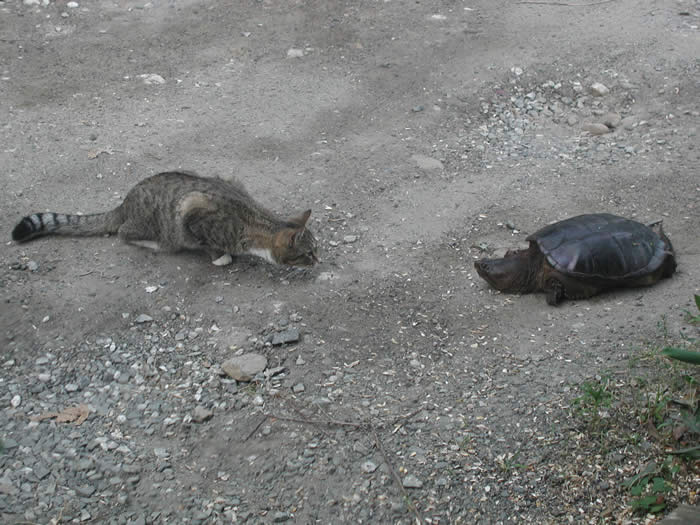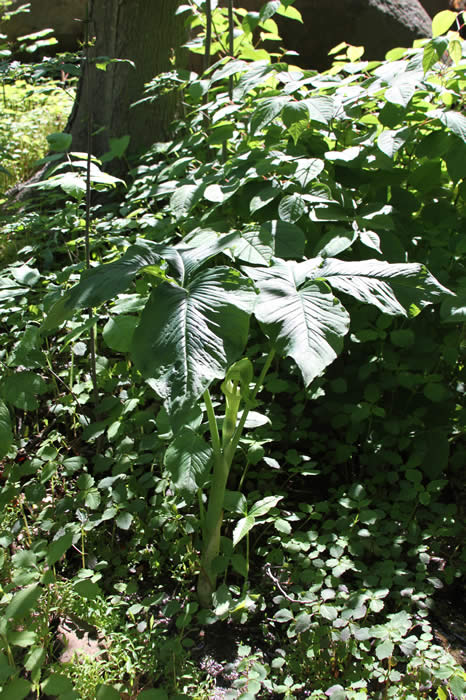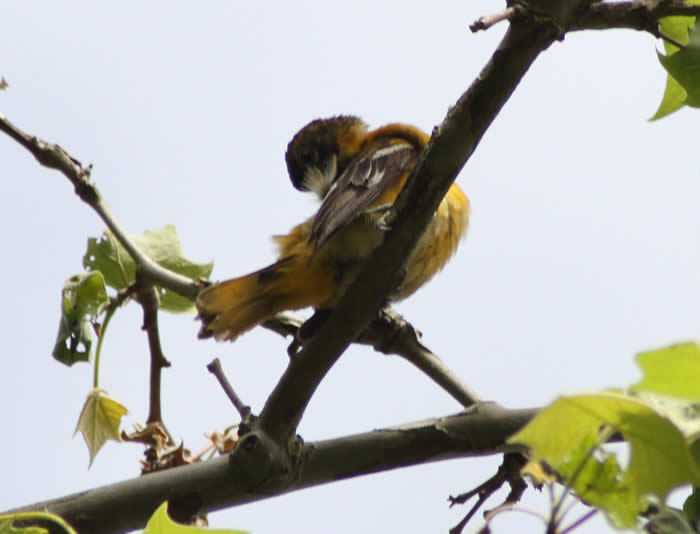The Hudson River Diaries A Compendium of Poetry and Natural History Gleaned from observations in and around Sparkill, New York |
Late May 2011 |
Few native wildfowl can rival the beauty of the American wood duck. This particular specimen was the proud father of–yes, nine!–fine little ducklings at the mouth of the Sparkill Creek. He and his wife were not in a position to flee–which is their usual behavior whenever humans are nearby–because of all their offspring. This gave me ample time to take a number of photographs. |
The female, with one of her adorable wards in tow. |
Young ones are strongly programmed to scoot for cover whenever threats--such as photographers--appear. |
The local cormorant has taken to fishing from the same stump almost every morning. This rather dramatic photo captured him at take off after I startled him. The subsequent photos in the series (not posted here) show that cormorants may kick off the water several times when taking off. |
 |
Ahhh, what a sad and unfortunate Latin name you have been given, you lovely bird! The American Robin is an extremely common sight around the Palisades. They are absolutely everywhere in the understory, grubbing for worms and bugs. |
|
 |
Another one of our “common” local animals, who is anything but common. The squirrel looks like a cuddly little bundle of fur, but like many rodents, they are extremely competitive and aggressive. I have seen squirrels face down a cat twice their size in my back yard. |
|
 |
What looks like a log breaking the surface of the water here is actually the snout of a common snapping turtle, a creature found in abundance in the Sparkill Creek-- yet another example of terrifically adaptive camouflage, which can be found all around us, not just on nature programs about the jungle! These turtles reliably lay their eggs and hatch according to lunar cycles; they were much in evidence over the past week during the full moon ( I saw three of them in the creek at the same time when I took this photograph,) and at the end of September, the hatchlings will emerge from their underground nests at the full moon and make their way back into the creek. Snapping turtle young go into hibernation immediately upon hatching, living beneath the mud until spring, sustained only by the energy they have when they hatch. Exactly how they manage to do this is a mystery.. |
|
 |
Our cat Holly makes an objectively alarming discovery in the driveway, May 2003 |
|
Up close and personal-- snapping turtles are a powerful predator you don't want to trifle with. Check out my instrumental song dedicated to this particular snapping turtle at this link: |
 |
The yellow flag Iris is an import from Europe that escaped from cultivation. The plant thrives in very wet conditions. Stands of it occur in the Sparkill pond; it blooms mid to late May. |
Yellow Star grass is a lovely little native American species in the Amaryllis family. These specimens were blooming in Tallman State Park on May 22. |
 |
Jack in the pulpit is a common sight in the woods In this area. This particular specimen was nearly 2 feet tall–a fine specimen. |
 |
The entire plant |
|
Isabel and I came across this white tailed deer lurking in the marsh at the foot of the Palisades. She crossed our path about a hundred feet in front of us, and I slowed down in the area she was seen to try and find her. There she was, carefully hidden on the banks of the Hudson with the salt marsh behind her. She was absolutely still as she watched us, convinced that she was invisible. I managed to creep up quite close to take this picture. |
 |
|
Our deer can be seen at the very bottom center of this photograph– with the salt marsh and, in the far distance across the river, the hills of Westchester behind her. She is standing below the point where the bank drops off into the marsh, which is why her head is so low. |
The Northern Cardinal is another common sight in our neighborhood. This plump female--who may be carrying eggs--is perched on one of last year's phragmites stalks. She was quite bold and sat patiently for a number of portraits. |
|
The Eastern chipmunk is probably the most common rodent around the Palisades. They are spunky, appealing creatures who project an irrepressibly positive attitude. They favor hiding holes in rocky areas. Last weekend, as I went into the forest I was greeted with a chorus of dozens of chipmunks all barking out their distinctive alarm sound–a sharp, high-pitched squeak–at the same time. This is very unusual; I walk through the same area all the time with the dog, and they are generally silent unless I get right on top of them. My suspicion is that it may have been some kind of mating communication, although I am unaware of any documentation of such behavior. |
|
The Baltimore oriole is not the most common bird in the area, but we do see them from time to time. This one was preening itself in a tree next to the river on May 22. |
|
caught mid-preen |
|
